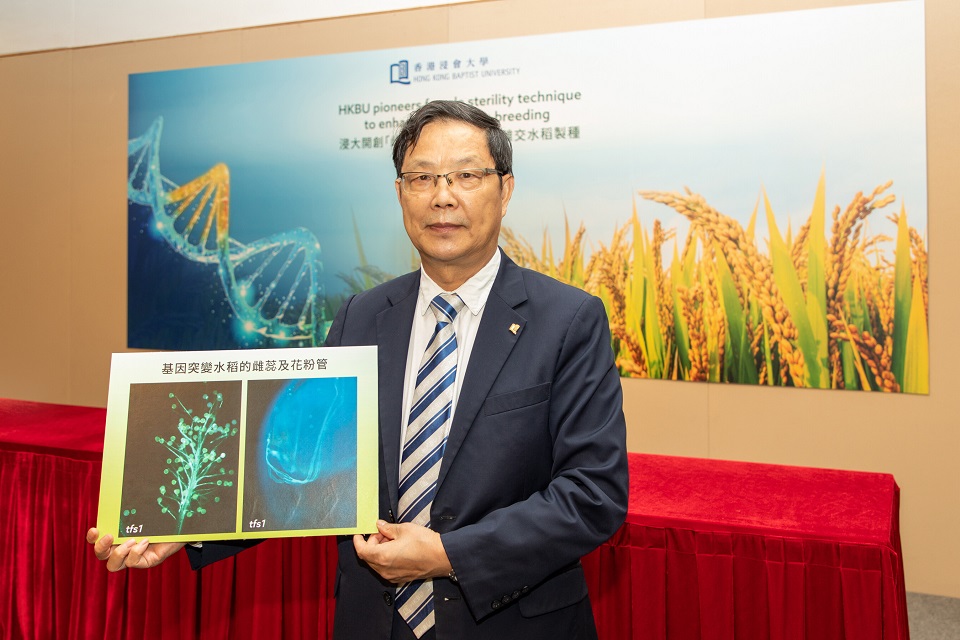Discover HKBU
New technique offers a breakthrough in the production of hybrid rice seeds
1 Dec 2022


Following groundbreaking work by Professor Yuan Longping, the “Father of Hybrid Rice”, scientists have developed hybrid rice breeding techniques by exploiting sterile male genes, and this has led to a substantial increase in rice yields over the past few decades. A research team led by HKBU has used a pioneering female sterility technique to enhance the efficiency of hybrid rice production. The novel approach enables fully automatic harvesting of hybrid seeds by machines, which can substantially reduce harvesting costs. The research results have been published in Cell Research, a top-ranking international scientific journal.
TFS1 mutation exhibits female sterility
The commonly used male sterility technique in hybrid rice seeds production first breeds cultivars, i.e. plant varieties, of the “male-sterile line” of rice as pollen receivers. Rice cultivars from the “restorer line” with normal fertility act as pollen donors, and they are grown close to the “male-sterile line” to facilitate pollen transfer for hybridisation. However, self-pollinating seeds can be produced by the “restorer line”, and they must be removed manually to avoid mixing them up with the hybrid seeds before mechanical harvest, resulting in high harvesting costs.
After nearly a decade of ongoing study, a research team led by Professor Zhang Jianhua, Chair Professor of the Department of Biology, has managed to identify a “spontaneous thermo-sensitive female sterility 1” (TFS1) gene mutation in an elite rice cultivar during paddy field production. This genetic mutation exhibits female sterility under regular or high temperature conditions (i.e. above 25°C), and fertility is partly resumed under low temperature conditions (i.e. 23°C). It does not have any defects in terms of its vegetative growth, and it can produce healthy pollen with normal male fertility. Rice with normal fertility can produce normal seeds after receiving pollen from rice with the TFS1 gene mutation.
Following genetic analysis using gene cloning and molecular techniques, the team found that the female sterility mutation is created by a point mutation in the genic region of Argonaute7 (AGO7), a member of the Argonaute (AGO) protein complex.
Great commercial potential with reduced harvesting costs
To evaluate the potential of using TFS1 as a genetic tool for hybrid rice production, the team conducted field trials in Hong Kong and Hunan Province in mainland China. The TFS1 gene mutation was introduced into three cultivars of rice by introgression and genome editing to create the germplasms with thermo-sensitive female sterility. They acted as the “restorer lines” for pollen donation. Another three cultivars of rice with male sterility were used as the “male-sterile lines”.
The team planted the “restorer lines” separately next to the “male-sterile lines” as in traditional hybrid breeding, or randomly mixed them on the farm when planting. In both planting arrangements, more than 30% of the panicles of the “male-sterile lines” in Hong Kong, and 40% in Hunan Province produced hybrid seeds. The proportion of seed sets is similar to the hybrid production yields using existing “restorer lines”, but the hybrid rice seeds can be harvested without the removal of the “restorer lines”.
Professor Zhang says: “Nowadays, producing hybrid rice seeds is still a labour-intensive process in agriculture. Female sterility, if it can be introduced into a ‘restorer line’ as a pure pollen donor, has great potential to reduce the cost, because the male and female parents of hybrid rice can be grown and harvested together by machines without worrying about seed purity.
“Our research findings provide a suitable trait for fully mechanised hybrid rice breeding, and our genetic tool has shown great promise for commercial applications. To maximise rice yields, we need further large-scale field trials to improve the receptibility between female and male-sterile lines.”
Apart from researchers from HKBU, the research team included scientists from the Hunan Agricultural University, the Guangdong Academy of Agricultural Sciences, the University of California at Davis, and the National Agriculture and Food Research Organisation in Japan.